Steady Progress
- Details
- Written by Kevin Horton
- Hits: 3525
I took a day of comp time on Tuesday to work on the aircraft. I woke up early, jumped in the shower, scarfed down my cereal, poured my coffee in a travel mug and headed to Rona to purchase some non-slip take for a temporary wing walk. I have a nice set of wing walks that I will install after the aircraft is painted, but I wanted a cheaper solution for the ones that will get pulled off prior to painting.
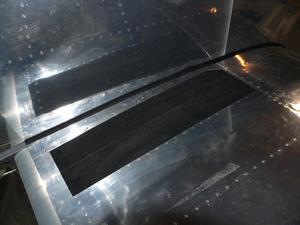 I trimmed the front inboard corner of the wing walk to keep it clear of the intersection fairing.
I trimmed the front inboard corner of the wing walk to keep it clear of the intersection fairing.
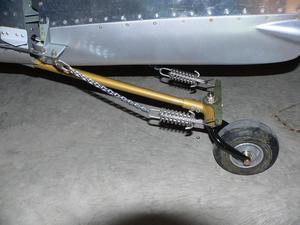 The eye bolts arrived from Aircraft Spruce, so I installed the tail wheel springs.
The eye bolts arrived from Aircraft Spruce, so I installed the tail wheel springs.
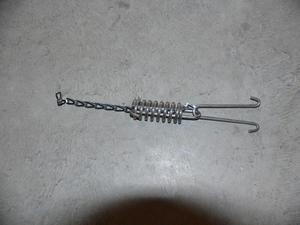 It took a bit of fiddling about to get the sash chains threaded onto the tail wheel springs, but I eventually discovered that the springs could be slipped apart, so the chain could be easily put in place.
It took a bit of fiddling about to get the sash chains threaded onto the tail wheel springs, but I eventually discovered that the springs could be slipped apart, so the chain could be easily put in place.
I did a static system leak check, finding that the system was pretty much leak free, as near as I could tell. I sucked the static system to raise the altimeter 1500 ft above the starting elevation, and once I held the pressure it seemed to lose perhaps 20 ft in one minute. It was hard to hold the tube I was sucking on hard against the static port, so it is quite possible that I lost the pressure there, rather than via a leak in the static system. The allowable tolerance is a loss of 100 ft in one minute, with the system at a pressure of 1000 ft above the starting elevation.
I knocked off several other small items during the day on Tuesday and on Wednesday evening.
Today we had the annual Smiths Falls Fly-In Breakfast. The weather was horrible, so it was more of a drive-in breakfast. This is the first year I have attended, so I wasn't sure what to expect. I am now a member of the flying club, so I helped out by spending two hours on serving duties, and another hour helping to clean up.
This afternoon I made and installed a "Roll Trim Inop" label to put beside the roll trim indicator (I'll hook up the spring bias system after I have sorted out any wing heaviness). I installed the instrument panel LED flood lights, and figured out why the engine instrument and avionics dimmers weren't working when I checked them a few days ago. It turns out that they work just fine if you have the main bus powered, rather than be an idiot and try to do a functional test with only the essential bus powered. I designed the system so that if the main bus is off line, the cockpit flood lights are still powered, but the engine instrument and CDI lights are dead. The dimmer for the avionics lights is unpowered, but I have the avionics configured to switch to using their internal photocell to set the lighting intensity if the dimmer power is dead.
While I was in the cockpit, checking the lighting, I noted that the magnetic compass was reading about 140° in error. This seems to be caused by the perhaps too close proximity to the steel canopy bow/roll bar. I pondered this issue on the way home, and eventually came up with a series of fall back plans. Plan A is to hope that there is enough authority in the adjusting magnets on teh compass to correct for this large error. This probably won't work. Plan B is to temporarily move the compass on top of the instrument panel, in the location where the accelerometer currently is located. This should allow me to get a valid compass swing, and allow the flight testing to start. Then I would somehow degauss the roll bar, allowing me to put the compass back in its location at the side of the instrument panel. Plan C, if I can't get the roll bar degaussed, is to make a new bracket for the top of the instrument panel, with the compass and the accelerometer beside each other.
I have taken Monday off, and hope to finish tidying up the wiring ahead of the instrument panel, and make some progress on the interface between the cowling air inlet and the plenum chamber on top of the engine.
Visitor
- Details
- Written by Kevin Horton
- Hits: 3275
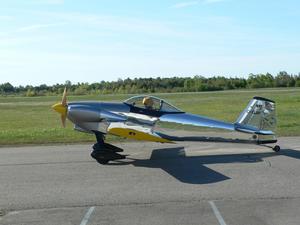 I arrived at the hangar at 0700 this morning, and not too long later Bruce MacKinnon showed up in his beautiful RV-3. Man that is a small aircraft. Bruce didn't even try to get out, as it is apparently quite a job to get himself folded back in place. We talked for a few minutes, then he left to finish his morning flight.
I arrived at the hangar at 0700 this morning, and not too long later Bruce MacKinnon showed up in his beautiful RV-3. Man that is a small aircraft. Bruce didn't even try to get out, as it is apparently quite a job to get himself folded back in place. We talked for a few minutes, then he left to finish his morning flight.
Inverted Oil System Breather
- Details
- Written by Kevin Horton
- Hits: 3227
I was on the road all week, and had a bunch of other stuff to do at home on Saturday, so I only got out to the hangar today.
I needed to fabricate a breather line for the inverted oil system. I wanted to run the breather line down between the exhaust pipes, so a rubber hose seemed out of the question.
 I didn't have a tubing bender for 3/4" aluminum hose, so I decided to try using sand to keep the tube from collapsing. I purchased two sets of flared fittings and end plugs. I flared the ends, installed one set of fittings, filled the 6' long tube with sand, then installed the fittings on the other end. I was able to bend the tube using some leather as a cushion, then cut it down to length.
I didn't have a tubing bender for 3/4" aluminum hose, so I decided to try using sand to keep the tube from collapsing. I purchased two sets of flared fittings and end plugs. I flared the ends, installed one set of fittings, filled the 6' long tube with sand, then installed the fittings on the other end. I was able to bend the tube using some leather as a cushion, then cut it down to length.
 I didn't get the breather line fully installed today, as I ran out of time. More pictures after I finish this job.
I didn't get the breather line fully installed today, as I ran out of time. More pictures after I finish this job.
Lower Wing Intersection Fairing
- Details
- Written by Kevin Horton
- Hits: 3271
 I noted that the wing intersection fairing didn't sit tight to the fuselage where it overlapped the lower fuselage skin. This meant that the rubber sealing strip wasn't pressed against the fuselage, and it seemed that it would come loose.
I noted that the wing intersection fairing didn't sit tight to the fuselage where it overlapped the lower fuselage skin. This meant that the rubber sealing strip wasn't pressed against the fuselage, and it seemed that it would come loose.
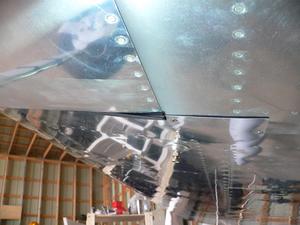 I decided to add an additional screw going into a nut plate on the portion of the lower fuselage skin that stuck out from the fuselage, right next to the fuselage side. This held the wing intersection fairing tightly in place, ensuring that the rubber sealing strip would be secure.
I decided to add an additional screw going into a nut plate on the portion of the lower fuselage skin that stuck out from the fuselage, right next to the fuselage side. This held the wing intersection fairing tightly in place, ensuring that the rubber sealing strip would be secure.
Brake Fluid
- Details
- Written by Kevin Horton
- Hits: 5184
Most RV builders use MIL-H-5606 brake fluid, which has been used by many general aviation aircraft for decades. This fluid has one big weakness though - it is very flammable, and has quite a low flash point (about 215°F). Brakes that have been used are quite hot, quite possibly hotter than the flash point of the brake fluid. Thus it is possible to have a brake fire. In fact, several RVs have had brake fires.
There are other options for brake fluid. The large air transport industry moved to a fire resistant brake fluid, marketed as Skydrol. But, this brake fluid is nasty, nasty stuff - it has some major human health issues, and it must be checked periodically to ensure that it has not become acidic, which can cause damage to brake system components.
Current automotive brake fluids do not burn, so they are an attractive option. RV-8 builder Charlie Kuss is a proponent of DOT 4 brake fluid. This brake fluid is not compatible with the Buna N O-rings used in general aviation brake systems. But, it is possible to replace those O-rings with ones made from EPDM (ethylene propylene). Charlie Kuss purchased a large number of all the needed O-rings, and sold kits to many RV builders. DOT 4 brake fluid does have one big issue though - it dissolves many types of paint, so a leak will make a big mess.
The US Air Force got tired of losing aircraft to brake fires, but they didn’t want to have to change out the O-rings on brake systems. So, they developed a brake fluid that was compatible with the Buna N O-rings used in MIL-H-5606 brake systems. MIL-PRF-83282 brake fluid has a much higher flash point than MIL-H-5606 (about 450°F), self-extinguishes once the external flame source is removed, can be mixed with MIL-H-5606 fluid, and can use the same O-rings.
I agonized over which type of brake fluid to use - DOT 4 or MIL-PRF-83282. I changed my O-rings for ones made from EPDM, as it was compatible with both DOT 4 and MIL-PRF-83282 (or so I thought - another builder pointed me to info which says that EPDM is not compatible with mineral oil - I need to do some more digging on this one), and it can stand much higher temperatures than Buna N. I eventually decided to go with MIL-PRF-83282 fluid, as I was concerned by the paint damage issue. Charlie Kuss claims that DOT 4 brake fluid won’t damage modern high quality paint, but my cockpit interior was painted with MarHyde from a spray bomb.
I couldn’t find MIL-PRF-83282 brake fluid in Ottawa, but I found that Leavens Brothers in Toronto stocked Royco 782, a MIL-PRF-83282 fluid. And it wasn’t expensive - only $12 a quart. If any other local RVers want some MIL-PRF-83282 brake fluid, I have quite a bit extra.
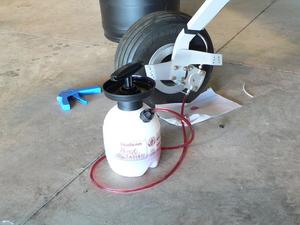 Today I filled the brake system. I decided to fill it from the bottom, using a modified pressure sprayer, as that would push the air to the top, hopefully avoiding any trapped air in the system. Things went smoothly at first, but then I looked in the cockpit and found a huge leak. I was sure that I had tightened all the connections, but it turned out that the connection inside the landing gear box was loose. I had to clean up several tea spoons of fluid. I was very, very glad that I had not used DOT 4 fluid.
Today I filled the brake system. I decided to fill it from the bottom, using a modified pressure sprayer, as that would push the air to the top, hopefully avoiding any trapped air in the system. Things went smoothly at first, but then I looked in the cockpit and found a huge leak. I was sure that I had tightened all the connections, but it turned out that the connection inside the landing gear box was loose. I had to clean up several tea spoons of fluid. I was very, very glad that I had not used DOT 4 fluid.
I pushed fluid in the right side until I had about a half inch in the bottom of the fluid reservoir (the highest point in the system). Then I moved to the left side and pushed fluid in until the reservoir was full (in fact, I got over zealous, and had fluid overflowing out the top).
I check the brake pedals, and as near as I can tell there is very little or no air in the system - the pedals feel fairly firm.
Misc Progress
- Details
- Written by Kevin Horton
- Hits: 3224
I've been beavering away on the last little stuff, making good progress. I ended up back in a phase where every time I finished one thing I saw a yet undetected new item that needed doing. In the past, I would simply add these new items to the big list, and put them off until "someday". But there aren't many "somedays" left until this thing must fly, so now if I see a new task, I try to do it right away, if possible.
I picked up the altimeter and altitude encoder from Woodlawn Instruments on Friday. They had done the required biennial adjustments and checks. They fixed a glitch with the encoder - when I first installed it, it appeared to be working correctly. But lately it was reporting an altitude that was hundreds of feet in error. And, now the altimeter reads within five feet of the one on the Dynon EFIS. Before it differed from the EFIS by about 50 ft.
Sunday I had planned to recheck the calibration of the EFIS ASI. I had checked it back in 2005, but the newest EFIS firmware has a feature that allows the calibration of the ASI zero pressure to be set, and I foolishly pushed that button. This probably means that the old calibration is no longer valid, so I decided to redo it. Before I started the calibration, I ran the ASI up to 220 kt to confirm there were no leaks. I found that the pitot system leaked a bit less than a kt per minute. This isn't a big enough leak to be an airworthiness concern, but it would make it very difficult to do an accurate calibration using a water manometer, as it takes some time to measure the water level, then read the ASI, and the ASI would be falling all that time. So, I spent four hours looking for the leak, tightening and resealing connections, then trying again. After four hours I gave up and moved on to starting to tidy up the wiring ahead of the firewall. I'll put off this pitot leak check until after I get flying. I'll attack it again sometime where there is a rainy day, and I'm in the mood for a puzzle.
